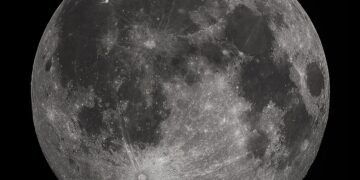On March 2, 2025, a remarkable milestone in lunar exploration was achieved as Firefly Aerospace’s Blue Ghost 1 lander successfully touched down on the Moon’s surface. This mission, part of NASA’s Commercial Lunar Payload Services (CLPS) initiative, carried the Southwest Research Institute’s (SwRI) Lunar Magnetotelluric Sounder (LMS)—an instrument designed to probe the Moon’s interior like never before.
The Lunar Magnetotelluric Sounder: A Game-Changer in Moon Exploration
The Lunar Magnetotelluric Sounder (LMS) is an advanced scientific instrument developed by SwRI to measure variations in the Moon’s natural electric and magnetic fields. This data will allow scientists to determine the electrical conductivity of the lunar subsurface, revealing essential details about its composition and internal structure.
Magnetotellurics has been widely used on Earth for locating underground resources like oil, water, and minerals, as well as studying geological processes such as continental shifts and volcanic activity. However, this is the first time the technique is being applied beyond Earth, marking a new era in planetary geophysics.
When Blue Ghost 1 landed, LMS was deployed in a cross-shaped configuration, with four sensors placed more than 60 feet away from the lander. This layout ensures accurate measurements of subsurface conductivity at different angles, enhancing the instrument’s ability to map the Moon’s underground structure.
Why Mare Crisium? The Perfect Landing Site
Unlike previous missions that focused on the Apollo landing sites, LMS was deployed in Mare Crisium, a 340-mile-wide ancient impact basin. This location was carefully chosen because of its geological distinctiveness.
During the Apollo era, most missions landed in regions with large, interconnected lava plains to the west, which were later found to be compositionally and structurally different from the rest of the Moon. These regions contain unusually high concentrations of elements such as thorium, suggesting a unique geological history.
Mare Crisium, however, stands apart. It offers a smooth landing site while being located outside of the Apollo-era anomalies. This makes it an ideal spot to collect data that better represents the Moon’s interior as a whole. The findings from LMS could provide a more accurate picture of the Moon’s subsurface structure, helping scientists understand its evolution and potential resources.
How Magnetotelluric Sounding Works on the Moon
The LMS instrument operates using a technique called magnetotelluric sounding, which relies on natural electromagnetic fluctuations to measure how well electricity flows through underground materials. On Earth, this method has been used to study tectonic activity, underground water reservoirs, and oil deposits.
Here’s how it works:
- Electric and Magnetic Field Measurement – LMS detects fluctuations in the Moon’s electric and magnetic fields caused by interactions with solar wind and cosmic radiation.
- Data Processing – The instrument analyzes these fluctuations to calculate the electrical conductivity of subsurface materials.
- Mapping the Lunar Interior – Conductivity differences reveal layers of rock, magma, or even potential underground water deposits.
Because magnetotelluric sounding is a non-invasive method, it allows scientists to study the Moon’s internal structure without the need for drilling—a critical advantage for future missions that aim to explore lunar resources.
The Role of Firefly Aerospace and Private Space Exploration
This mission is not just about science—it also represents a major milestone for private spaceflight. Firefly Aerospace has now become the first commercial company to successfully land on the Moon, proving that private companies can play a leading role in deep-space exploration.
Under NASA’s CLPS initiative, the agency has started partnering with commercial space companies to send scientific instruments and technology demonstration missions to the Moon. This shift reduces costs for NASA while accelerating lunar research.
Firefly Aerospace’s Blue Ghost 1 mission carried multiple scientific payloads, with LMS being one of the most important. By demonstrating the success of a privately-built lander, Firefly has opened the door for future commercial lunar missions, potentially paving the way for private moonbases and resource extraction projects.
What We Hope to Learn from LMS
The Lunar Magnetotelluric Sounder’s findings could transform our understanding of the Moon in several ways:
- Determining the Moon’s Internal Composition – LMS can reveal whether the Moon’s interior contains magma pockets, metallic layers, or water-rich deposits.
- Unraveling the Moon’s Thermal History – By analyzing how heat has been distributed underground, scientists can better understand the Moon’s formation and evolution.
- Assessing Future Resource Potential – If LMS detects water ice or mineral-rich regions, it could influence future lunar mining operations and human settlement plans.
How This Mission Paves the Way for the Future
The success of LMS and the Blue Ghost 1 mission sets the stage for bigger and more ambitious lunar projects. This mission is part of NASA’s broader Artemis program, which aims to return humans to the Moon by 2026 and eventually establish a permanent lunar base.
With data from LMS, scientists will be able to:
- Identify safe landing zones for future crewed missions
- Locate potential water reserves for lunar habitats
- Assess underground conditions for building Moon bases
Conclusion: A New Era in Lunar Science
The deployment of the Lunar Magnetotelluric Sounder aboard Firefly Aerospace’s Blue Ghost 1 lander marks a major leap in lunar exploration. This first-of-its-kind mission will provide crucial data about the Moon’s interior, revealing details about its formation, structure, and resource potential.



















